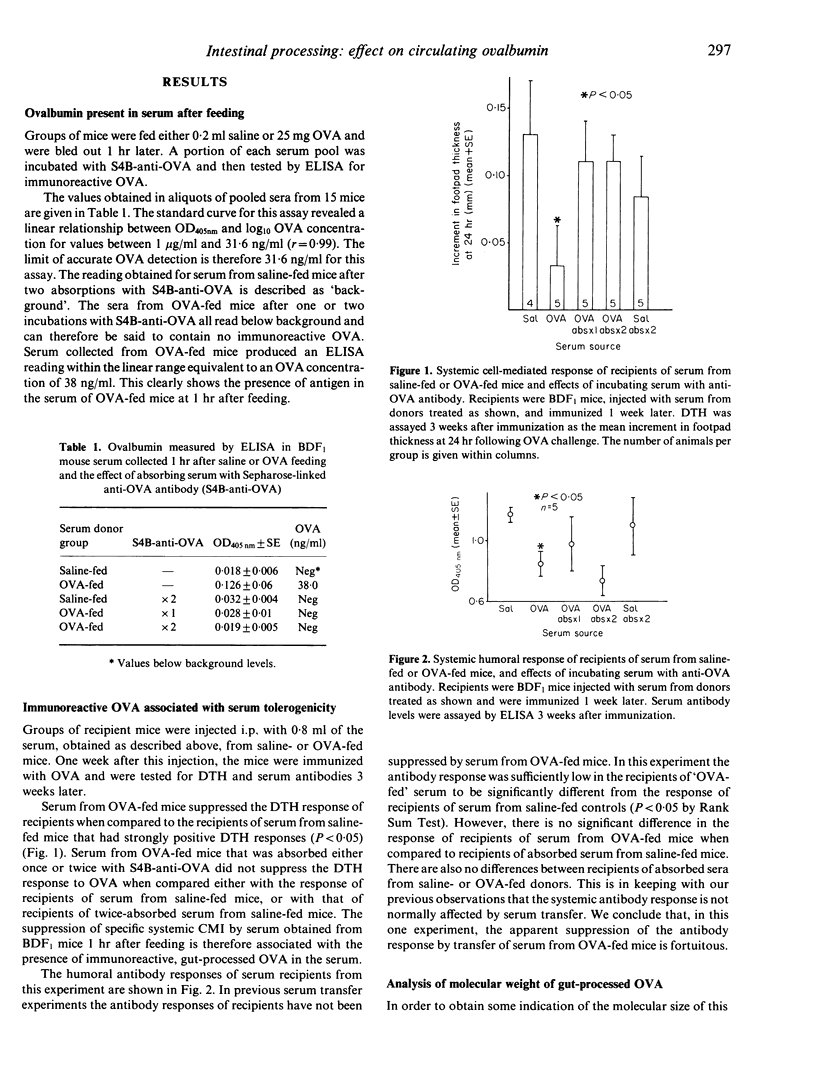Abstract
The presence of a tolerogen in mouse serum within 1 hr of antigen feeding prompted further study. Therefore, serum from mice fed with ovalbumin (OVA) was subjected to various immunochemical and biological tests. The appearance of tolerogen in serum was concomitant with the presence of OVA detected by a specific ELISA. Absorption of tolerogenic serum with anti-OVA antibody coupled to Sepharose beads effectively removed the tolerogenic moiety from the serum and confirmed that not only was tolerogenicity associated with the presence of antigen, but that binding sites for antibody were intact on this tolerogenic form of OVA. Finally, serum fractions from antigen-fed mice were assayed for total protein content, ELISA-detectable OVA and in vivo effect on systemic immunity. The only serum fraction in which immunoreactive OVA was detected contained proteins close to the molecular weight of native OVA and induced significant immune suppression in recipients. Serum fractions lacking immunoreactive OVA were not significantly tolerogenic in vivo. These experiments confirm that when OVA is absorbed across the gut mucosa it is subtly altered into a tolerogenic form. The recognition of gut-processed OVA by T-suppressor cells is discussed.
Full text
PDF





Selected References
These references are in PubMed. This may not be the complete list of references from this article.
- Bruce M. G., Ferguson A. Oral tolerance to ovalbumin in mice: studies of chemically modified and 'biologically filtered' antigen. Immunology. 1986 Apr;57(4):627–630. [PMC free article] [PubMed] [Google Scholar]
- Endres R. O., Grey H. M. Antigen recognition by T cells. I. Suppressor T cells fail to recognize cross-reactivity between native and denatured ovalbumin. J Immunol. 1980 Oct;125(4):1515–1520. [PubMed] [Google Scholar]
- Mowat A. M., Strobel S., Drummond H. E., Ferguson A. Immunological responses to fed protein antigens in mice. I. Reversal of oral tolerance to ovalbumin by cyclophosphamide. Immunology. 1982 Jan;45(1):105–113. [PMC free article] [PubMed] [Google Scholar]
- Sercarz E. E., Yowell R. L., Turkin D., Miller A., Araneo B. A., Adorini L. Different functional specificity repertoires for suppressor and helper T cells. Immunol Rev. 1978;39:108–136. doi: 10.1111/j.1600-065x.1978.tb00398.x. [DOI] [PubMed] [Google Scholar]
- Shimonkevitz R., Colon S., Kappler J. W., Marrack P., Grey H. M. Antigen recognition by H-2-restricted T cells. II. A tryptic ovalbumin peptide that substitutes for processed antigen. J Immunol. 1984 Oct;133(4):2067–2074. [PubMed] [Google Scholar]
- Skogh T. Overestimate of 125I-protein uptake from the adult mouse gut. Gut. 1982 Dec;23(12):1077–1080. doi: 10.1136/gut.23.12.1077. [DOI] [PMC free article] [PubMed] [Google Scholar]
- Strobel S., Mowat A. M., Drummond H. E., Pickering M. G., Ferguson A. Immunological responses to fed protein antigens in mice. II. Oral tolerance for CMI is due to activation of cyclophosphamide-sensitive cells by gut-processed antigen. Immunology. 1983 Jul;49(3):451–456. [PMC free article] [PubMed] [Google Scholar]


